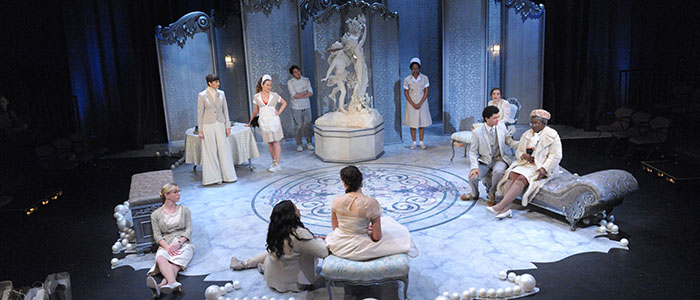Tartuffe or Not Tartuffe?
This blog post is by Kathleen Kelly, a junior government & politics and communications double major.

Tartuffe, originally written in French by Molière in 1664, was vibrantly brought to life by the UMD School of Theatre, Dance, and Performance Studies this season. The play depicts how a family’s life is turned upside down as a certain houseguest by the name of Tartuffe acts as the moral authority over all their lives, when in fact Tarfuffe is nothing more than a hypocrite who enjoys meddling in their lives. This interpretation of one of the most famous comedies written by Molière is delightfully comical and great fun for the entire audience.
UMD’s School of Theatre, Dance, and Performance Studies added some modern touches to their interpretation of the play. Characters were often seen playing on their cell phones, or would call each other to inform them of the goings-on in the house.The addition of modern technology to the storyline of the play only helped make it more relatable to audience members.
From the beginning of the play the audience knows that Tartuffe is not to be trusted, and they follow the family’s struggle to help expose Tartuffe’s true self to Damis, the head of the household. In a semi-circle round theater stage, the characters often speak out to audience members without the other characters hearing, making many situations ironically comical and entertaining, and often evoking great laughter from the audience. While the original play was set in 1664, the major themes and situations portrayed in the play are still quite relevant today. Themes of envy, and distrust, lust and deceit are prevalent throughout the play’s storyline, leaving the audience on the edge of their seats as they follow the plot’s twists and turns.
UMD’s School of Theatre, Dance, and Performance Studies added some modern touches to their interpretation of the play. Characters were often seen playing on their cell phones, or would call each other to inform them of the goings-on in the house. The addition of modern technology to the storyline of the play only helped make it more relatable to audience members.
As a collective ensemble, the actors all played off each other’s energy and comedic style seamlessly. It was hard to identify one’s favorite character not only because each character was so distinct from the others, but they all brought their own unique type of comedy to the stage. Audience members cannot help but fall in love with the oblivious father, the love-struck son, the loudmouthed housekeeper, the cunning wife, and all the other characters. Both the characters as well as the audience are united by their mutual hatred of Tartuffe, and everyone finds relief when his true nature is finally exposed.
